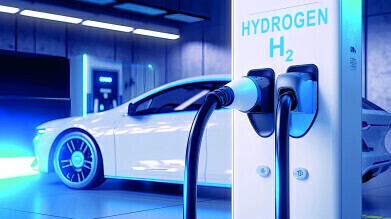Hydrogen fuel
Why green ammonia is unlikely to be the fuel of the future – but might just be its side-kick
Nov 01 2023
The quest for a zero-carbon future has ignited interest in various energy carriers and fuels that can potentially replace fossil fuels. Among the candidates, hydrogen stands out as a front-runner due to its high energy content and zero-emission profile upon combustion or use in fuel cells. Ammonia (NH3), often touted for its ease of storage and transport, might seem like another promising option. However, its prospects as a fuel are dimmed by significant drawbacks, making it more suitable as a hydrogen storage medium rather than a fuel for the future.
The argument against ammonia as a direct fuel is twofold: compatibility with fuel cells and pollution from combustion.
Firstly, most fuel cells, designed to generate electricity through a chemical reaction, are optimized for pure hydrogen. While research is ongoing into direct ammonia fuel cells, these technologies are nascent and currently less efficient compared to their hydrogen counterparts. The process of cracking ammonia back into hydrogen to feed standard fuel cells adds an extra layer of complexity and energy use, making it less direct and efficient than using hydrogen alone.
Secondly, when ammonia is combusted, it releases nitrogen oxides (NOx), which are potent pollutants contributing to smog and acid rain, and have significant health impacts. Controlling these emissions requires additional technologies that increase the complexity and cost of using ammonia as a fuel. This environmental burden undermines the very goal of transitioning to cleaner energy systems.
Despite these challenges, ammonia has not been sidelined in the renewable energy conversation. It has a promising role as a storage medium for hydrogen. Ammonia's chemical stability allows it to be liquified more easily than hydrogen—at atmospheric pressure, it liquifies at -33°C, compared to hydrogen which requires a chilling -253°C. This property significantly simplifies the logistics of storage and transport.
How, then, can ammonia be transformed back into hydrogen? The process is known as ammonia cracking, and it involves catalytic or thermal methods to break the chemical bonds between nitrogen and hydrogen atoms in the ammonia molecule. The result is the release of hydrogen gas and nitrogen. With advances in catalytic technologies, this process is becoming more efficient, positioning ammonia as a potential 'hydrogen carrier' that could enable the global distribution of hydrogen energy.
Turning to hydrogen, its role in a zero-carbon future is anchored in two critical applications: as a combustible material for industrial processes and as a means of generating electricity.
In industries that require high-temperature processes, such as steel or cement manufacturing, hydrogen can be combusted directly, producing water vapor as the only byproduct. This direct use bypasses the energy losses associated with converting hydrogen into electricity, then into heat, offering a cleaner alternative to fossil fuels without requiring extensive changes to existing infrastructure.
Furthermore, hydrogen is poised to play a vital role in energy systems through fuel cell technology. Fuel cells convert the chemical energy of hydrogen directly into electricity, with higher efficiency than internal combustion engines and without the intermittent nature of solar or wind power. They offer a means to store energy in a form that is readily convertible to electricity, providing a solution for both base-load and peak power generation.
While batteries are also efficient and essential for short-term energy storage and supply, hydrogen has the advantage for long-duration storage and scalability. Batteries face challenges in raw material supply, costs, and life cycle environmental impacts, particularly for large-scale applications. In contrast, hydrogen can be produced wherever there is water and renewable electricity, such as solar or wind power, and stored indefinitely in large quantities.
While ammonia's environmental impact as a fuel makes it a less favorable candidate for direct energy applications, its utility as a hydrogen storage medium is undeniable. Ammonia enables the harnessing, storage, and transport of hydrogen's clean energy across vast distances, from places where renewable energy is abundant to where it is needed.
Hydrogen's role in the zero-carbon economy is multifaceted: as a clean combustible for industry and as a flexible, efficient energy carrier for electricity generation. Its integration into the global energy system is pivotal for achieving deep decarbonization and tackling the climate crisis head-on.
In the end, the energy transition is likely to see ammonia and hydrogen working in tandem, with each playing to its strengths to create a more sustainable and resilient energy future.
Digital Edition
PIN 25.5 Oct/Nov 2024
November 2024
Analytical Instrumentation - Picturing Viscosity – How Can a Viscometer or a Rheometer Benefit You? - Sustainable Grease Formulations: Evaluating Key Performance Parameters and Testing Method...
View all digital editions
Events
Jan 20 2025 San Diego, CA, USA
Jan 22 2025 Tokyo, Japan
Jan 25 2025 San Diego, CA, USA
SPE Hydraulic Fracturing Technology Conference and Exhibition
Feb 04 2025 The Woodlands, TX, USA
Feb 05 2025 Guangzhou, China



















